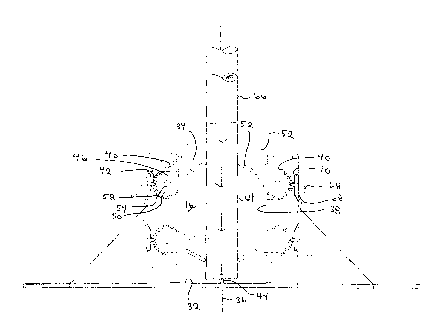Une partie des informations de ce site Web a été fournie par des sources externes. Le gouvernement du Canada n'assume aucune responsabilité concernant la précision, l'actualité ou la fiabilité des informations fournies par les sources externes. Les utilisateurs qui désirent employer cette information devraient consulter directement la source des informations. Le contenu fourni par les sources externes n'est pas assujetti aux exigences sur les langues officielles, la protection des renseignements personnels et l'accessibilité.
L'apparition de différences dans le texte et l'image des Revendications et de l'Abrégé dépend du moment auquel le document est publié. Les textes des Revendications et de l'Abrégé sont affichés :
| (12) Brevet: | (11) CA 2148721 |
|---|---|
| (54) Titre français: | STAND A ELEMENT VERTICAL |
| (54) Titre anglais: | VERTICAL MEMBER SUPPORT STAND |
| Statut: | Périmé et au-delà du délai pour l’annulation |
| (51) Classification internationale des brevets (CIB): |
|
|---|---|
| (72) Inventeurs : |
|
| (73) Titulaires : |
|
| (71) Demandeurs : | |
| (74) Agent: | |
| (74) Co-agent: | |
| (45) Délivré: | 2000-04-04 |
| (22) Date de dépôt: | 1995-04-27 |
| (41) Mise à la disponibilité du public: | 1995-11-03 |
| Requête d'examen: | 1998-04-23 |
| Licence disponible: | S.O. |
| Cédé au domaine public: | S.O. |
| (25) Langue des documents déposés: | Anglais |
| Traité de coopération en matière de brevets (PCT): | Non |
|---|
| (30) Données de priorité de la demande: | ||||||
|---|---|---|---|---|---|---|
|
A vertical member support stand is described which
includes a body with a generally tubular vertical member
receiving cavity. The cavity has a bottom, a top opening, and
circumferential sidewalls. At least three upper pressure
members are substantially equally spaced around the
circumferential sidewalls of the vertical member receiving
cavity adjacent the top opening. The pressure members are
pivotally mounted whereby they are pivoted into engagement
with a vertical member positioned in the vertical member
receiving cavity. At least three lower pressure members are
substantially equally spaced around the circumferential
sidewalls of the vertical member receiving cavity adjacent the
bottom. The pressure members are pivotally mounted whereby
they are pivoted into engagement with a vertical member
positioned in the vertical member receiving cavity. The
pressure members are locked in a selected pivotal position
such that they securely hold the vertical member.
Note : Les revendications sont présentées dans la langue officielle dans laquelle elles ont été soumises.
Note : Les descriptions sont présentées dans la langue officielle dans laquelle elles ont été soumises.

2024-08-01 : Dans le cadre de la transition vers les Brevets de nouvelle génération (BNG), la base de données sur les brevets canadiens (BDBC) contient désormais un Historique d'événement plus détaillé, qui reproduit le Journal des événements de notre nouvelle solution interne.
Veuillez noter que les événements débutant par « Inactive : » se réfèrent à des événements qui ne sont plus utilisés dans notre nouvelle solution interne.
Pour une meilleure compréhension de l'état de la demande ou brevet qui figure sur cette page, la rubrique Mise en garde , et les descriptions de Brevet , Historique d'événement , Taxes périodiques et Historique des paiements devraient être consultées.
| Description | Date |
|---|---|
| Inactive : CIB de MCD | 2006-03-11 |
| Inactive : CIB de MCD | 2006-03-11 |
| Le délai pour l'annulation est expiré | 2003-04-28 |
| Inactive : Demande ad hoc documentée | 2003-01-29 |
| Lettre envoyée | 2002-04-29 |
| Accordé par délivrance | 2000-04-04 |
| Inactive : Page couverture publiée | 2000-04-03 |
| Préoctroi | 2000-01-10 |
| Inactive : Taxe finale reçue | 2000-01-10 |
| Un avis d'acceptation est envoyé | 1999-07-09 |
| Un avis d'acceptation est envoyé | 1999-07-09 |
| Lettre envoyée | 1999-07-09 |
| Inactive : Approuvée aux fins d'acceptation (AFA) | 1999-06-25 |
| Lettre envoyée | 1998-07-23 |
| Inactive : Renseign. sur l'état - Complets dès date d'ent. journ. | 1998-07-23 |
| Inactive : Dem. traitée sur TS dès date d'ent. journal | 1998-07-23 |
| Inactive : Lettre officielle | 1998-05-01 |
| Inactive : Lettre officielle | 1998-05-01 |
| Exigences pour une requête d'examen - jugée conforme | 1998-04-23 |
| Toutes les exigences pour l'examen - jugée conforme | 1998-04-23 |
| Inactive : Demande ad hoc documentée | 1997-04-28 |
| Réputée abandonnée - omission de répondre à un avis sur les taxes pour le maintien en état | 1997-04-28 |
| Demande publiée (accessible au public) | 1995-11-03 |
| Date d'abandonnement | Raison | Date de rétablissement |
|---|---|---|
| 1997-04-28 |
Le dernier paiement a été reçu le 1999-04-21
Avis : Si le paiement en totalité n'a pas été reçu au plus tard à la date indiquée, une taxe supplémentaire peut être imposée, soit une des taxes suivantes :
Veuillez vous référer à la page web des taxes sur les brevets de l'OPIC pour voir tous les montants actuels des taxes.
| Type de taxes | Anniversaire | Échéance | Date payée |
|---|---|---|---|
| Requête d'examen - petite | 1998-04-23 | ||
| TM (demande, 3e anniv.) - petite | 03 | 1998-04-27 | 1998-04-23 |
| TM (demande, 4e anniv.) - petite | 04 | 1999-04-27 | 1999-04-21 |
| Taxe finale - petite | 2000-01-10 | ||
| TM (brevet, 5e anniv.) - petite | 2000-04-27 | 2000-04-27 | |
| TM (brevet, 6e anniv.) - petite | 2001-04-27 | 2001-04-23 |
Les titulaires actuels et antérieures au dossier sont affichés en ordre alphabétique.
| Titulaires actuels au dossier |
|---|
| JACQUES ROBERT |
| Titulaires antérieures au dossier |
|---|
| S.O. |